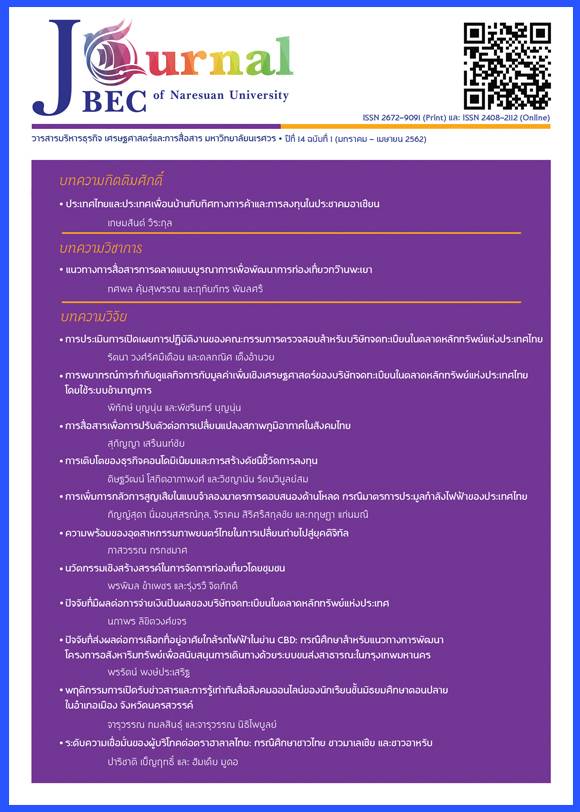พฤติกรรมการเปิดรับข่าวสารและการรู้เท่าทันสื่อสังคมออนไลน์ของนักเรียนชั้นมัธยมศึกษาตอนปลาย ในอำเภอเมือง จังหวัดนครสวรรค์
Main Article Content
บทคัดย่อ
การวิจัยนี้เป็นการวิจัยเชิงปริมาณด้วยวิธีการสำรวจ กลุ่มตัวอย่างคือนักเรียนชั้นมัธยมศึกษาตอนปลายในอำเภอเมือง จังหวัดนครสวรรค์ จำนวน 400 คน ผลการวิจัย พบว่า 1) กลุ่มตัวอย่างส่วนใหญ่เป็นเพศหญิง ร้อยละ 69.5 เรียนอยู่ชั้นมัธยมศึกษาปีที่ 4 ร้อยละ 38.8 2) กลุ่มตัวอย่างมีพฤติกรรมการเปิดรับข่าวสารจากสื่อดั้งเดิม ค่าเฉลี่ย 2.61 มีพฤติกรรมการเปิดรับข่าวสารจากสื่อสังคมออนไลน์ ค่าเฉลี่ย 3.91 3) กลุ่มตัวอย่างมีความสามารถในการรู้เท่าทันสื่อสังคมออนไลน์ในภาพรวมอยู่ในระดับมาก ค่าเฉลี่ยอยู่ที่ 4.03 4) ผลการทดสอบสมมติฐาน พบว่า นักเรียนมัธยมศึกษาตอนปลายที่มีระดับชั้นที่แตกต่างกันมีพฤติกรรมการเปิดรับข่าวสารด้านสื่อดั้งเดิม ด้านสื่อสังคมออนไลน์ ด้านความถี่ในการเปิดรับสื่อสังคมออนไลน์ (ต่อสัปดาห์) และด้านระยะเวลาในการเปิดรับสื่อสังคมออนไลน์ (ต่อวัน) แตกต่างกันอย่างมีนัยสำคัญทางสถิติที่ระดับ 0.05 นักเรียนมัธยมศึกษาตอนปลายที่มีสถานภาพสมรสของบิดามารดาที่แตกต่างกันมีพฤติกรรมการเปิดรับข่าวสารด้านสื่อดั้งเดิม แตกต่างกันอย่างมีนัยสำคัญทางสถิติที่ระดับ 0.05 นักเรียนมัธยมศึกษาตอนปลายที่มีที่พักอาศัยในปัจจุบันที่แตกต่างกันมีพฤติกรรมการเปิดรับข่าวสาร ด้านความถี่ในการเปิดรับสื่อสังคมออนไลน์ (ต่อสัปดาห์) และด้านระยะเวลาในการเปิดรับสื่อสังคมออนไลน์ (ต่อวัน) แตกต่างกันอย่างมีนัยสำคัญทางสถิติที่ระดับ 0.05 5) ผลการทดสอบสมมติฐานพบว่า นักเรียนที่สถานภาพสมรสของบิดามารดาแตกต่างกันมีระดับการรู้เท่าทันสื่อสังคมออนไลน์แตกต่างกันอย่างมีนัยสำคัญทางสถิติที่ระดับ 0.05
Article Details
เอกสารอ้างอิง
2. Biggins, O. (2012). Media and information literacy. Suthiparithat Journal, 26(80), 147-161.
3. Cronbach, L. J. (1951). Coefficient alpha and the internal structure of tests. Psychometrika Journal, 16(3), 297-334.
4. Jitsang, K. (2014). Relationship between personal and group factors with internet literacy skills of youth in Khon Kaen municipality. Information Journal, 21(1), 46-60.
5. Kaewthep, K. (1999). Communication for development. Bangkok: The Thailand Research Fund Research Report.
6. Kawesuti, S. (2010). Internet usage behavior, media literacy and self-protection form internet privacy violations. Master Thesis, M.A. (Communication Arts), Chulalongkorn University, Bangkok.
7. Kongrath, P. (2011). Study of social networking behavior of teenagers in Thailand: Facebook case study. Master Thesis, M.S. (Technology Management), Thammasat University, Bangkok.
8. Michael, A. Z. and O’Neil, K. (1976). How to implement privacy and security. New York: S.I. Theorem.
9. National Statistical Office Thailand. (2016). Explore the use of information and communication technology in the household, 2019. Retrieved March 8, 2017, from http://service.nso.go.th/nso/web/survey/surtec5-1-3.html
10. Nunnally, J. C. (1978). Psychometric theory (2nd ed.). New York: McGraw-Hill.
11. Office of Secondary Educational Service Area 42, Nakhon Sawan and Uthai Thani. (2015).
High school student statistics in Nakhon Sawan province. Retrieved March 6, 2017,
from http://www.secondary42.obec.go.th/
12. Office of the National Broadcasting and Telecommunications Commission. (2013). What is media literacy?. Retrieved March 8, 2017, from http://bcp.nbtc.go.th/th/detail/2017-01-24-23-12-51
13. Potter, W. J. (2011). Media Literacy (6th ed.). California: SAGE.
14. Promvongsa, S. (2010). Internet behavior and media literacy according to the perception of upper secondary school students in Nong Bua Lam Phu province. Master Thesis, M.A. (Communication Technology), Udon Thani Rajabhat University, Udon Thani.
15. Rattanapornnukul, J. (2007). Media exposure behavior of generation M in Mueang district Chiang Mai province. Independent Study, M.B.A., Chiang Mai University, Chiang Mai.
16. Reid, A. (2014). Five online standards and ethics pointers for journalists. Retrieved March 10, 2017, from http://www.journalism.co.uk/news/five-online-standards-and-ethics-pointers-forjournalists/s2/a552745/
17. Somjing, J. (2014). Media and information literacy and deviant behavior of youth who are at risk in Trang province. Master Thesis, M.A. (Communication Arts and Information), Kasetsart University, Bangkok.
18. Suna, N. (2012). Media literacy in using online media of undergraduate students in department of Digital Communication. Master Thesis, M.A., Maejo University, Chiang Mai.
19. The National Press Council of Thailand. (2010). The National Press Council of Thailand and the News Broadcasting Council of Thailand Guideline topic the use of social media in the mass media 2010. Retrieved March 6, 2017, from http://www.presscouncil.or.th/?page_id=64
20. Treerayapiwat, M. (2010). Journalist and social media. Retrieved March 6, 2017, from
http://www.tja.or.th/index.php?option=com_content&view=article&id=1683%3A-social-media-&catid=46%3Aacademic&Itemid=7
21. Warren, S. D. and Brandeis, L. D. (1890). The right to privacy. Retrieved March 6, 2017, from
https://www.cs.cornell.edu/~shmat/courses/cs5436/warren-brandeis.pdf
22. Williamson, A. (2013). Social media guidelines for parliaments. Retrieved March 15, 2017, from http://www.ipu.org/PDF/publications/SMG2013EN.pdf
23. Yamane, T. (1973). Statistics: An introductory analysis (3rd ed.). New York: Harper and Row.
24. Yenjabok, P. (2009). Decrypt the idea for media literacy. Bangkok: Offset Creation.


